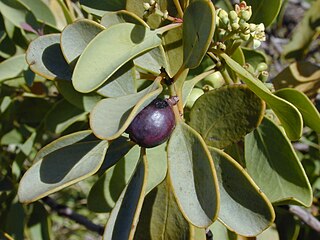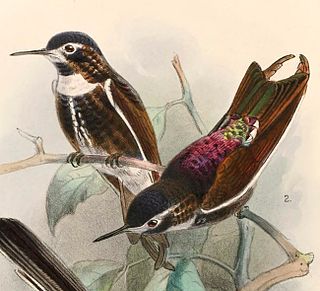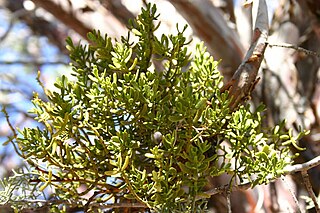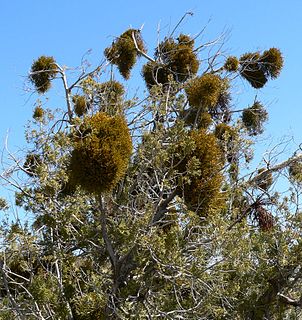
Mistletoe is the common name for obligate hemiparasitic plants in the order Santalales. They are attached to their host tree or shrub by a structure called the haustorium, through which they extract water and nutrients from the host plant.

The Santalaceae, sandalwoods, are a widely distributed family of flowering plants which, like other members of Santalales, are partially parasitic on other plants. Its flowers are bisexual or, by abortion, unisexual. Modern treatments of the Santalaceae include the family Viscaceae (mistletoes), previously considered distinct.

Senegalia greggii, formerly known as Acacia greggii, is a species of tree in the genus Senegalia native to the southwestern United States and northern Mexico, from the extreme south of Utah south through southern Nevada, southeast California, Arizona, New Mexico and western Texas to Baja California, Sinaloa and Nuevo León in Mexico. The population in Utah at 37°10' N is the northernmost naturally occurring Senegalia species anywhere in the world.

Nuytsia floribunda is a hemiparasitic tree found in Western Australia. The species is known locally as moodjar and, more recently, the Christmas tree or Western Australian Christmas tree, as the display of intensely bright flowers during the austral summer coincides with the Christmas season.

Viscum album is a species of mistletoe in the family Santalaceae, commonly known as European mistletoe, common mistletoe or simply as mistletoe. It is native to Europe and western and southern Asia.

Phoradendron is a genus of mistletoe, native to warm temperate and tropical regions of the Americas. The center of diversity is the Amazon rainforest. Phoradendron is the largest genus of mistletoe in the Americas, and possibly the largest genus of mistletoes in the world. Traditionally, the genus has been placed in the family Viscaceae, but recent genetic research acknowledged by the Angiosperm Phylogeny Group shows this family to be correctly placed within a larger circumscription of the sandalwood family, Santalaceae.

Rhododendron macrophyllum, the Pacific rhododendron, California rosebay, California rhododendron, coast rhododendron or big leaf rhododendron, is a large-leaved species of Rhododendron native to the Pacific Coast of North America. It is the state flower of Washington.

The purple-backed sunbeam is a bird species in the family Trochilidae. It is found only in Peru.

Phoradendron leucarpum is a species of mistletoe in the Viscaceae family which is native to the United States and Mexico. Its common names include American mistletoe, eastern mistletoe, hairy mistletoe and oak mistletoe. It is native to Mexico and the continental United States. It is hemiparasitic, living in the branches of trees. The berries are white and 3–6 millimeters (0.12–0.24 in). It has opposite leaves that are leathery and thick. Ingesting the berries can cause "stomach and intestinal irritation with diarrhea, lowered blood pressure, and slow pulse". This shrub can grow to 1 meter (3.3 ft) by 1 meter (3.3 ft).

Arceuthobium divaricatum is a species of dwarf mistletoe known as pinyon dwarf mistletoe. It is native to the southwestern United States and Baja California, where it lives in woodlands as a parasite on various species of pine, particularly Colorado Pinyon and Single-leaf Pinyon. This is a small shrub which is visible as a network of scaly brown or greenish stems no more than 12 centimeters long extending above the bark of its host tree. Most of the mistletoe is located inside the host tree, attached to it via haustoria, which tap the tree for water and nutrients. The leaves of the mistletoe are reduced to thin scales on its surface. It is dioecious, with male and female mistletoe plants producing spikes of staminate and pistillate flowers, respectively. The fruit is a sticky berry a few millimeters long which explodes to disperse the seeds it contains several meters away from the parent plant and its host tree.

Arceuthobium douglasii is a species of dwarf mistletoe known as Douglas fir dwarf mistletoe. It is native to western North America from British Columbia to Texas to California, where it lives in forest and woodland as a parasite. It is found mostly on Douglas fir trees, but occasionally on fir, as well.

Phoradendron californicum, the desert mistletoe or mesquite mistletoe, is a hemiparasitic plant native to southern California, Nevada, Arizona, Sonora, Sinaloa and Baja California. It can be found in the Mojave and Sonoran Deserts at elevations of up to 1400 m.

Phoradendron densum Trel. is a species of flowering plant in the sandalwood family known by the common name dense mistletoe. It is native to the western United States and northwestern Mexico, where it grows in various types of woodland habitat. It has been reported from California, Oregon, Arizona and Baja California. This mistletoe parasitizes species of cypress, including Arizona cypress, and juniper.

Phoradendron juniperinum is a species of flowering plant in the sandalwood family known by the common name juniper mistletoe. It is native to the southwestern United States and northern Mexico, where it grows in various types of woodland habitat. It has been reported from California, Nevada, Arizona, New Mexico, Oregon, Utah, Texas, Chihuahua and Sonora.
Phoradendron libocedri is a species of flowering plant in the sandalwood family known by the common name incense-cedar mistletoe. It is native to western North America from Oregon to Baja California, where it grows in forests on its host tree, the California incense-cedar.

Phoradendron pauciflorum is a species of flowering plant in the sandalwood family known by the common name fir mistletoe. It is native to coniferous forests in California, Arizona, and Baja California.

Phoradendron villosum is a species of flowering plant in the sandalwood family known by the common names Pacific mistletoe and oak mistletoe. It is native to western North America from Oregon south into Mexico, where it grows in oak woodland and similar habitat.

Phoradendron tomentosum, the leafy mistletoe, hairy mistletoe or Christmas mistletoe, is a plant parasite. It is characterized by its larger leaves and smaller berries than dwarf mistletoe. Leafy mistletoe seldom kill but they do rob their hosts of moisture and some minerals, causing stress during drought and reducing crop productions on fruit and nut trees. Leafy mistletoe has the ability to photosynthesize on its own but it relies on other plants in order to obtain its nutrients. It attaches itself to a tree and then grows haustoria, in order to get the food and water it needs.
Phoradendron coryae, Cory's mistletoe or oak mistletoe, is a hemiparasitic plant native to the southwestern United States and northern Mexico. It is reported from Arizona, New Mexico, Texas, Chihuahua, Coahuila and Sonora.
Phoratoxins are a group of toxins that belong to the family of thionins, a subdivision of small plant toxins. Phoratoxins are proteins present in the leaves and branches of the Phoradendron, commonly known as the American variant of the mistletoe, a plant commonly used as decoration during the festive season. The berries of the mistletoe do not contain phoratoxins, making them less toxic compared to other parts of the plant. The toxicity of the mistletoe is dependent on the host tree, since mistletoe is known to be a semi-parasite. The host tree provides fixed inorganic nitrogen compounds necessary for the mistletoe to synthesize phoratoxins.
















